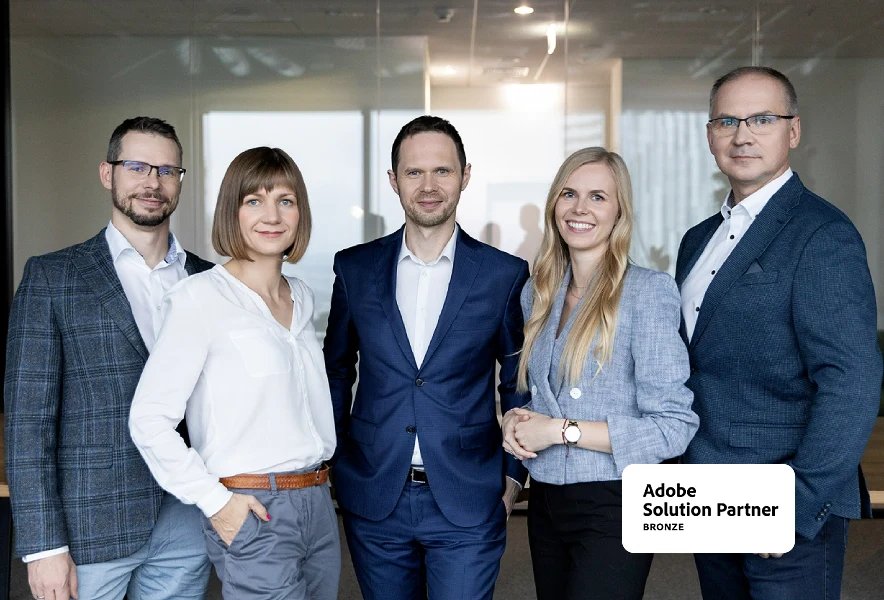Looking for a powerful AEM portal to boost your online presence?
Are you considering migrating your valuable content to Adobe Experience Manager (AEM) for enhanced authoring, management, and delivery capabilities?
Our AEM content migration services offer a comprehensive solution to seamlessly transition your data from various platforms to the robust AEM environment.
With our expertise in AEM migration services, we ensure a smooth and efficient process, minimizing disruption to your operations.
Our AEM content migration services encompass the utilization of AEM authoring capabilities, content fragments, authoring services, and advanced migration tools. We leverage these resources to streamline the migration process, empowering you to take advantage of AEM’s powerful features and functionalities.
Our team of skilled professionals understands the intricacies involved in migrating content to AEM. We employ industry-leading migration tools and methodologies to ensure data integrity, metadata preservation, and optimal performance in the new AEM environment. We offer end-to-end solutions, from assessing your migration requirements to executing the migration process seamlessly.
We provide guidance and support throughout the migration journey, ensuring a successful transition to the AEM cloud.
To facilitate a smooth migration experience, we offer comprehensive checklists, best practices, and guidance for AEM implementation.
We understand that each migration is unique, and our tailored approach ensures that your specific business needs and objectives are met.
Contact us today for seamless migrations from non-AEM platforms to AEM and take your content to new heights.
Our work process during migration to Adobe Experience Manager.
Discovery of the scope of migration
- Definition of the scope of migration as-is: the status of the current site, scope of the content for migration, identification of templates, components, integrations.
- Scope of rework – current pain points, required changes, extensions.
- Redesign and approval of the final layout after migration.
Pilot
- Definition of the goals, the scope and acceptance criteria of the pilot. What answers need to be provided at this tage?
- Delivery of a Minimum Viable Product (MVP) on AEM platform.
- Conclusions from the pilot stage, Go-Nogo decision, optionally: rescoping and rescheduling of the next phases of the project.
Portal migration to AEM within the agreed scope
- Definition of user stories, acceptance criteria, test scenarios for the scope.
- Agile, SCRUM based development of templates, custom components, integrations on AEM platform.
- Continuous engagement of the client to verify and optionally adjust the process of migration to meet the client’s business needs.
- Building automated tests can be considered on this stage.
User Acceptance Tests
- Execution of the test scenarios on the new portal, including multiple devices and browsers.
- This stage can be performed by the client, by TTMS or together.
- This stage includes also performance tests and security tests if required.
Content migration to the new portal
- All the relevant content including multiple language version is migrated to the new portal.
- This is a good moment also to filter the content and eliminate the outdated part of it.
New AEM Portal go-live
- Final verification of the content, redirections from the old portal, publication, announcement of the new webpage.
Portal hyper-care period
- Just after the go-live there is always higher risk that some issues with the functionality of the website, the integrations or the content will appear. For that reason we recommend a period of 2- to 4-weeks of hyper-care, where our development team will be in stand-by to fix any problems.
Decommissioning of old portal
- The development of old portal should be frozen at some stage of the migration process. The precise moment of the freeze will depend on business needs, but definitely the switch between portals must have place during go-live.
- The old portal can be maintaned for hyper-care period for backup purposes, or even longer if required. But as it maintenance required costs and effort, it can be decomissioned anytime after go-live.
At every stage, your project will be taken care of by our teams of professionals and experts:
We will then be at your service to further the maintenance and development of the site or to hand over the platform to your hands. In case the AEM technology appears to be challenging, we also offer assistance or partial engagement in the development process, according to your needs.
>Who can benefit from our Product Catalog Development services?
We are here to support you in developing smooth AEM PIM Integration, which will help your company to improve efficiency, customer experience and increased agility. Why not having in your solution:
- always up-to-date product information
- reduced time spent on updating product information in many places
- one source of truth about product data
contact us
CIOs, CTOs, Heads of IT
The right timing and speed are key in business. CIOs, CTOs, and Heads of IT are aware of this rule, but their possibilities to improve are limited when systems used in the company are separated. When CMS and PIM are not integrated, you must rely on time consuming manual processes with a high risk of errors.
Lack of AEM PIM Integration means that your IT specialist can’t use the full potential of both systems.
CMOs, Heads of Digital, and Heads of Marketing
It’s crucial to provide your customers with up-to-date, reliable product information across all online channels. However, it’s not easy to coordinate data exchange between company departments, external vendors, and others.
Although your Teams have access to powerful CMS, they work with incomplete, outdated product information. It leads to extended time to market and limits the possibilities of international development.
Read about our other specializations in AEM:
All clients
AEM clients
The world’s largest corporations have trusted us
Why TTMS?
Get to know our advantages as AEM Services Migration Provider
We will ensure the optimal way to migrate the portal, considering all of your business priorities
You will control the progress of migration and its results
We will ensure the continuous availability of your portal and a seamless switch to its new version
The data you will entrust with us will be safe at every stage of your project
You get certified quality services
Ready to migrate your content to new horizons with seamless transitions from non-AEM platforms to AEM? Contact us today and unlock the full potential of your content journey.
You will have the opportunity to experience AEM in practice
Discover what challenges our clients faced by reading the use case.
Global Producer of Hunting Arms Case
Global Manufacturing Enterprise Case
FAQ
What is an AEM migration?
AEM Migration is the process of moving your website with all its content and digital assets from one platform to another – in this case to Adobe Experience Manager, which is on the leading edge when it comes to simplicity, availability, variety of functions and security.
Two solutions are up for consideration: migration to AEM in the cloud and migration to on-premise environments. Adobe recommends the option based on AEM in the cloud. AEM in the cloud always provides the newest features as it is regularly updated on the go. AEM migration includes building a new website on the AEM platform and content migration that is moving all the valid content – texts, digital assets, page structure – from the old website to the AEM-based one. Contact us to learn more about the AEM platform’s possibilities, and we will help you decide how to approach the website migration to AEM in your case.
How to do content migration in AEM?
Content migration is moving the content (text, digital assets) from one website platform to another. There may be different reasons to do that. One is migrating the whole website from the non-AEM platform to AEM (See: What is an AEM migration). Content or data migration to Adobe Experience Manager is the last stage of such a project before publishing the site. In the content migration process, first of all, the content of your current website needs to be analyzed. Is all the data up-to-date? Do you need to reorganize the site structure? What bothers you with your current solution? What can be improved? Is the design your primary concern, or do you wish to have more flexibility, reliability, and customization of core components that don’t serve your needs? Migration can be a complex process, and the scope depends on your answers to the questions above. Its goal can be just lifting-and-shifting of the current website to the new platform or reworking it to give its a new look and clean up invalid parts of the content. Our teams of AEM experts can handle each of these tasks and, thanks to strong relationships and excellent communication between teams, deliver the best possible outcome.
What high-level questions need to be known for content migration to AEM?
Who can help me provide the content migration?
You have to find a team to provide data migration to Adobe Experience Manager. You can select the team from your own employees. But take into consideration that the manual migration process, sometimes including multiple language version can be really time-consuming, going to months of fulltime job. We can offer you experienced AEM content authors and managers, who will do that for you.
How much does it cost?
It all depends on the amount of content, number of products, number of language versions etc. Normally, the cost is proportional to the amount of content, but AEM is a clever tool and we know the tricks how to make it shorter. Contact us and ask for effort estimates and timeline.
What tools do I need to perform content migration?
Not too many. AEM Authoring Tool is a perfect one and already in place. Also, we suggest using project management tools like for example JIRA. Also we recommend Agile SCRUM approach. Is it only dedicated for software development? Not really! And actually with such approach you will always perfectly control the progress of work and be sure that things are on track. If this concept sounds reasonable for you contact us for more information.
What are the best practices in manual content migration to AEM?
Manual content migration might feel like an arduous and time-consuming task. Still, it has benefits such as setting components’ properties on the go, avoiding asset localization issues, and discovering development-related matters as soon as they occur. To make the process as fast and efficient as possible, it’s crucial to organize the work of the content Author team using proper tools and methodology. An inventory of existing content must be done, and priorities should be set in case of an enormous number of pages. The whole process might be divided into sprints to make it transparent for the client and easy to track. Authors work closely with Developers and Testers to ensure that the final outcome meets all the project requirements.
How much time does migration to AEM take?
The project timeline depends on the scope and complexity of your project – design, development, and the amount of content to be moved. How big is the website? How rich are the current components, and how many are in use? How many templates? Do you have a new design, or would you like to have it created? Is it one-to-one migration, or how many changes to the current site would you like to introduce during the migration process? Do you have any integrations of the site with external systems? Feel free to contact us and discuss the details – and we will prepare individual estimations for your project.
How to find and hire AEM developers experienced in migration?
Before hiring developers to migrate content to AEM, you should check a few essential things. In the case of migration, being an experienced developer means spending thousands of hours working on various types of portals. While searching for reliable migration services, preferably Adobe Solution Partners, check how long your potential contractor has been on the market and what were his past projects. Remember that large businesses often require confidentiality agreements and cannot be mentioned by name. However, valuable information about the industry, type of portal, or the process itself might be found in case studies. Certified Adobe Experience Manager developers can use the vast customization capabilities of AEM to deliver you the most powerful and best solution on the market.
From which platforms can you migrate my portal/website?
We can propose AEM migration services from different CMS and platforms, for example:
- Sitecore to AEM migration services
- WordPress to AEM migration services
- CQ5 to AEM migration (AEM upgrade)
- Drupal to AEM migration
- content migration from IBM WCM to AEM
- data migration from Demandware platform to AEM
etc.
Tell us more about your website engine/CMS/platform and your goals, and our AEM consultants will help you to find the best solution for your needs and plan and estimate your project.
Ready to take your business to the next level?
Let’s talk about how TTMS can help.

Krzysztof Stachowiak
Head of AEM








